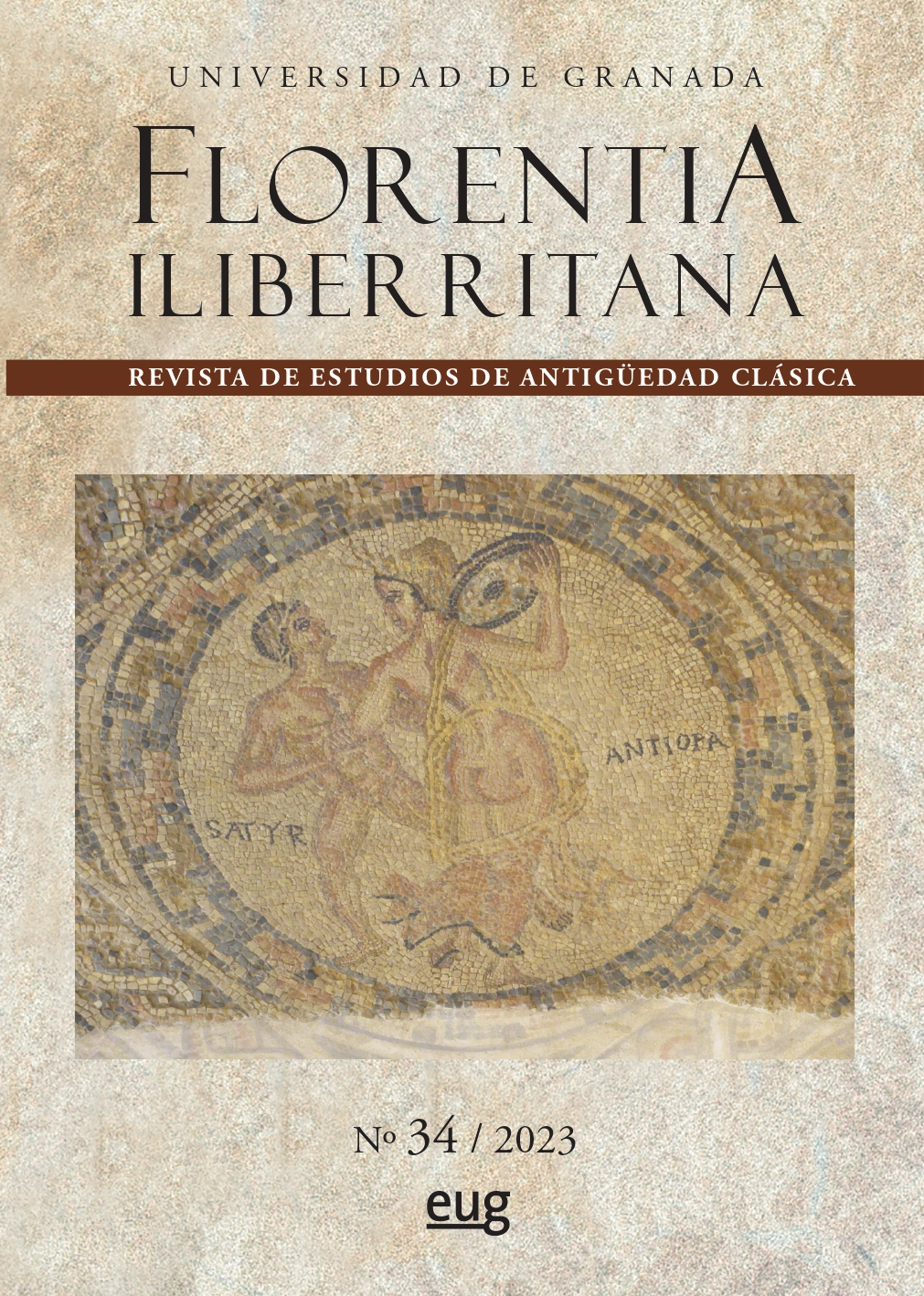La strix romana: análisis y caracterización
DOI:
https://doi.org/10.30827/floril.v34.27837Schlagworte:
strix, escatología romana, alteridad, brujería, hechiceríaAbstract
Se propone un estudio exhaustivo e individualizado de la strix dentro del pensamiento simbólico romano. Para ello, se analizan las principales fuentes textuales que permiten caracterizarla desde la Antigüedad hasta finales de la Edad Media. El resultado muestra como una criatura maléfica vinculada inicialmente con la muerte, la noche y la alteridad acabó evolucionando a otra realidad asociada a la hechicería, la brujería y la antropofagia.
Downloads
Literaturhinweise
AHN RÍOS, María Soraya (2016), La transformación de la lamia antigua en bruja moderna: Edición crítica y traducción del De lamiis et pithonicis mulieribus de Ulrich Molitor (1489). Tesis doctoral inédita. Universidad de Barcelona.
AHN RÍOS, María Soraya & GUZMÁN ALMAGRO, Alejandra (2013), «Enigmas de identidad: ¿Lamias, Estriges o brujas? en De Lamiis et Pythonicis Mulieribus y otros tratados demonológicos del siglo XV», Anuari de Filologia. Antiqvua et mediaevalia 3: 1-23.
ALVAR NUÑO, Antón (2009-2010), «Nocturnae Aves: su simbolismo religioso y función mágica en el mundo romano», Arys 8: 187-202.
BRIL, Jacques (1984), Lilith ou la Mère Obscure. París, Payot.
CAMPAGNE, Fabián Alejandro (2009), Strix hispánica. Demonología cristiana y cultura folklórica en la España moderna. Buenos Aires, Prometeo Libros.
CHERUBINI, Laura (2010), Strix. La strega nella cultura romana. Siena, UTET.
CORRADI MUSI, Carla (1995), Vampiri Europei e Vampiri dell'Area Sciamancia. Soveria Mannelli, Rubbetino.
ELIADE, Mircea (1975), «Some Observations on European Withcraft», History of Religions 14. 3: 149.-172. DOI: https://doi.org/10.1086/462721
FARAONE, Christopher A. (1999), Ancient Greek Love Magic. Cambridge, Cambridge University Press. DOI: https://doi.org/10.4159/9780674036703
FEDELI, Paolo, DIMUNDO, Rosalba & CICCARELLI, Irma (2015), Properzio. Elegie. Libro IV. Nordhausen, Verlag Traugott Bautz.
GINZBURG, Carlo (1989), Storia notturna. Una decifrazione del sabba. Torino, Einaudi.
GONZÁLEZ TERRIJA, Alejandro Arturo (2015), La dulce mano que acaricia y mata: figuras siniestras femeninas en el mundo infantil grecolatino. Tesis doctoral inédita. UNED.
GRIMAL, Pierre (1981), Diccionario de mitología griega y romana. Barcelona, Paidós.
HURWITZ, Siegmund (1992), Lilith. The first Eve. Historical and Psychological Aspects of the Dark Feminine. Einsiedeln, Daimon Verlag.
JOHNSTON, Sarah Iles (1995), «Defining the Dreadful: Remarks on the Greek Child-Killing Demon», en Marvin Meyer & Paul Mirecki (eds.), Ancient Magic and Ritual Power. Leiden, Brill: 361-387. DOI: https://doi.org/10.1163/9789004283817_019
JOHNSTON, Sarah Iles (1997), «Corinthian Medea and the Cult of Hera Akraia», en James J. Clauss & Sarah Iles Johnston (eds.), Medea. Essays on Medea in Myth, Literature, Philosophy and Art. Princeton: Princeton University Press: 44-70 DOI: https://doi.org/10.2307/j.ctv10vm25j.7
JOHNSTON, Sarah Iles (1999), Restless Dead. Encounters between the Living and the Dead in Ancient Greece. Berkeley, University of California Press.
LINNEO, Carlos (1758), Systema naturae: per regna tria naturae, secundum classes, ordines, genera, species, cum characteribus, differentiis, synonymis, locis. Holmiae, Impensis Direct. Laurentii Salvii. DOI: https://doi.org/10.5962/bhl.title.542
LITTLEWOOD, R. Joy (2006), A Commentary on Ovid: Fasti Book VI. Oxford, Oxford University Press.
MALTBY, Robert (2002), Tibullus: Elegies. Text, Introduction and Commentary. Leeds, Francis Cairns.
MAXWELL TEITEL, Paule (2017), Canidia, Rome's First Witch. Londres, Bloomsbury.
MCDONOUGH, Christopher Michael (1997), «Carna, Proca and the Strix on the Kalends of June», Transactions of the American Philological Association 127: 315-344. DOI: https://doi.org/10.2307/284396
OGDEN, Daniel (2002), Magic, Witchcraft and Ghosts in the Greek and Roman Worlds. New York, Oxford University Press.
OLIPHANT, Samuel (1913), «The Story of the Strix: Ancient», Transactions and Proceedings of the American Philological Association 44: 133-149 DOI: https://doi.org/10.2307/282549
OLIPHANT, Samuel (1914), «The Story of the Strix: Isidorus and the Glossographers», Transactions and Proceedings of the American Philological Association 45: 49-63 DOI: https://doi.org/10.2307/282687
PEREA YÉBENES, Sabino (2002), «Las striges: mujeres-pájaro, lujuriosas, devoradoras», en Sabino Perea Yébenes, El sello de Dios (2): Ceremonias de la Muerte. Nuevos estudios sobre la magia y creencias populares greco-romanas. Madrid, Signifer Libros: 235-277.
PHILLIPS, Oliver (2002), «The Witches' Thessaly», en Paul Mirecki & Marvin Meyer (eds.), Magic and Ritual in the Ancient World. Boston, Brill: 378-386. DOI: https://doi.org/10.1163/9789047400400_021
SCOBIE, Alex (1978), «Strigiform Witches in Roman and Other Cultures», Fabula 19: 74-101 DOI: https://doi.org/10.1515/fabl.1978.19.1.74
SCURLOCK, Jo Ann (1991), «Baby-Snatching Demons, Restless Souls and the Dangers of Childbirth: Medico-Magical Means of Dealing with Some of the Perils of Motherhood in Ancient Mesopotamia», Incognita 2: 135-183.
STRAMAGLIA, Antonio (1999), Res inauditae, incredulae. Storie di fantasmi nel mondo Greco-latino. Bari, Levante.
Downloads
Veröffentlicht
Zitationsvorschlag
Ausgabe
Rubrik
Lizenz
Copyright (c) 2024 Florentia Iliberritana

Dieses Werk steht unter der Lizenz Creative Commons Namensnennung - Nicht-kommerziell - Weitergabe unter gleichen Bedingungen 4.0 International.
















